Half-Life Q&A
We sit down with Gearbox Software president Randy Pitchford to discuss the latest developments in his company's latest game, the PlayStation 2 port of Half-Life.
Lately, Texas-based Gearbox Software has been making a name for itself as the premier third-party developer of Half-Life-related games. The company began its run with Opposing Force, the critically acclaimed expansion pack for Half-Life, and then followed it up with Blue Shift, another successful add-on for the classic shooter. Currently, the company is working Counter-Strike: Condition Zero for the PC and a Half-Life conversion for the PlayStation 2. Now that the latter game is only a few weeks away from shipping to stores, we took this opportunity to sit down with Gearbox president Randy Pitchford to discuss a number of details about this promising game.
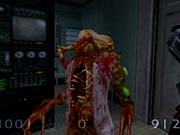
GameSpot: So far, all of Gearbox's released games and projects in the works have been related to Half-Life in some way. Certainly Gearbox knows more about that series than any other developer, but do you ever worry that the company will become typecast?
Randy Pitchford: When we announced that we were working on Opposing Force, I got some questions about games myself and my partners had been involved with before Gearbox. Now, most people have either forgotten or never knew about that past. If we make quality games, no matter what the subject matter is, they will speak for themselves. In any case, Gearbox likes the Half-Life stuff. We've made some great games, won some awards, sold a lot of copies, helped out the user community, and generally made fans very happy. Who's complaining?
GS: Certainly not us. Let's talk about Half-Life for the PlayStation 2. How long has the game been in development? From what we've seen of the game, it seems to be finished.
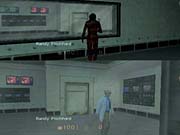
RP: Half-Life for the PlayStation 2 started development more than one year ago. And yes, it's just about finished.
GS: How big is the team that's working on this game? How does that number compare with the size of some of your other projects?
RP: During the product peak of Half-Life for the PlayStation 2 development, Gearbox had as many as 18 people working on it. At other times in the project, the team was as small as five people. This is one of the largest teams we've had, because we've had to write a significant amount of rendering and other engine system technology specifically for the PlayStation 2, we've created an entirely new game (Decay), we've reworked all of the game's content including a complete rebuild with a fourfold detail upgrade of all the game's models, and we've added a bunch of new game modes and other hidden features for fun. This is a significant project, and we're very proud of the result.
GS: Blue Shift was admittedly a short game. How many hours will it take for an average player to complete the Decay levels in Half-Life PS2?
RP: Decay isn't as long as Half-Life, but it will probably take most players about twice as long to complete Decay as it took to complete Blue Shift. Also, Decay has some other skill tests in things like accuracy, amount of damage taken, and so on. Depending on how you do, you'll be given a grade. If you can earn an "A" grade in every mission, you'll unlock a secret that will allow you to become an alien. This includes a special cooperative alien mission for Decay and the ability to play through the original Half-Life as an alien. It is cool stuff, and it adds quite a bit of play time to the game.
GS: It's clear that the PlayStation 2 version of Half-Life uses a lot of the Hi-Def character and weapon models from Blue Shift. Decay notwithstanding, what else was added into the game to take advantage of the PlayStation 2 hardware?
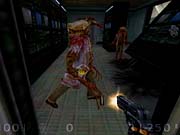
RP: Actually, the models in Half-Life for the PlayStation 2 are about twice as detailed as those released in the Hi-Def Pack with Blue Shift. The PS2 models are superior in that they have full facial articulation, which allows blinking and tracking eyes and real facial expressions and emotions. This is great because it really adds a new sense of horror to the game. When a scientist is about to get eaten by an alien, you can really see the fear on his face. In addition, the PS2 version has some added LOD [level of detail] technology that allows us to dynamically increase or reduce detail depending on how far away a character is from the player. This really helps us keep the frame rate blazing--even in scenes with lots of characters on the screen.
There is quite a lot of other custom technology and content in the PlayStation 2 version of Half-Life--too much to cover all the PS2-specific features here. A lot of work was spent rewriting the rendering software to use the PS2's vector units. This gives us a lot of speed and makes things look nice. We've also done a lot of engineering with compression and getting data so that load times on the PlayStation 2 are actually faster than they were in the original PC version when it was released. I think the feature I like to show off most, however, is the true 16:9 aspect widescreen support. This is especially great when playing Decay with a friend because the screen is then split vertically and each half of the screen on the widescreen TV is essentially the same size and aspect ratio of a separate TV. Neat stuff...
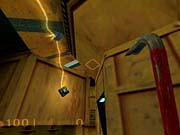
GS: The game feels fine with the controller, but some people will undoubtedly want to play the game using a mouse and keyboard. Will you be supporting that feature in Half-Life PS2?
RP: USB keyboards and mice are fully supported and easily configurable in the onscreen menus. We're proud to make Half-Life for the PS2 the most controller-friendly and configurable FPS game on the platform. Gearbox, however, invested quite a bit of time and engineering in making sure the game is very fun using the Dual Shock 2 controller. We've added quite a lot of features for this, including a lock-on targeting system that is quite a lot like the "Z targeting" feature found in the Zelda games. We've also reworked the interface for some of the more complex moves like long jumping and crouch jumping to make them very friendly with a controller. Finally, we went into the environments themselves and tuned everything for play using the Dual Shock 2. This includes changing the size and angles of difficult jumping platforms on the alien world, as well as the elimination of required crouch jumps in the heavy combat sections in the Black Mesa research facility. As a result, the game is very fun when played with a Dual Shock 2.
GS: What took the most time during development, converting Half-Life from the PC to the PlayStation 2 or creating the Decay levels?
RP: Decay was a long time in development because we did something no one's ever done before. We created a truly cooperative game with a narrative. We didn't want to make the cooperative game simply be exactly like a single-player game, but with another player there. We wanted to get the players to work together to overcome obstacles and defeat challenges. In Decay, the players are required to work together to get things done. Also, the characters of Decay are very closely involved in the overall Half-Life plot. So they are there below the barrel that Gordon, the main character in the original game, is working in when the famous Half-Life accident occurs.
The technology was also being worked on from day one to the last day of the project, so quite a bit of time and effort was dedicated to that. You see, Half-Life isn't just a straight port. We didn't trim or sacrifice content to make things work. With Half-Life, we went in the other direction. We wanted the experience to be better, take advantage of what the PS2 was good at, and generally be the most fun it could be. So, we upgraded the original award-winning game and added a complete new game, while at the same time rethinking how the interface is handled. So, there was a lot of new engineering that was done to allow those improvements and changes to be made.
GS: You've now had the opportunity to develop for the PC, Dreamcast, and PlayStation 2 platforms. What are some of the specific advantages and disadvantages of working on the PlayStation 2 as opposed to the PC? Which platform is your favorite?
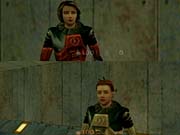
RP: The PlayStation 2 is a fixed platform, so the fear of compatibility issues like we have on the PC goes away. On the other hand, that advantage makes the platform very rigid. There are no new video cards with new features coming along on the PlayStation 2 for us to take advantage of. We also have to treat data management entirely differently. PC's have lots of RAM and fast permanent storage. Console systems have a CD and just a bit of system memory. Many of the things we're good at on the PC were advantages to us when developing for the PlayStation 2. Many of the things we learned that are important on the PlayStation 2 would be very good things to bring back to the PC. I'm really looking forward to future projects on both platforms where our experience will help us make our software much cleaner and faster.
GS: Do you have any plans to release Decay as an expansion pack for Half-Life on the PC? Don't you agree that it'd be a logical move?
RP: The argument was valid for Blue Shift, and we're ecstatic that it reached number one on the PC sales charts in the US and in the UK, but right now there are no plans to bring Decay to the PC.
GS: Is there anything else you'd like to tell our readers about Half-Life for the PlayStation 2?
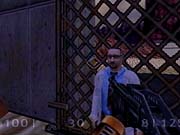
RP: When we started the project, we knew that the original Half-Life on the PC is believed by many to be the greatest game of all time. So, we knew it was important to preserve the story and action that earned that prestige. However, it was also really important for us to bring Half-Life to the next generation as far as graphics and technology go so that it really stood out on the PlayStation 2. Additionally, we took a look at what the PlayStation 2 could do and what playing console games is all about, and we decided that we wanted to also create a new Half-Life game that is specifically designed for the console in that it can be played by friends sitting around the living room having a good time and has incentives and features that encourage replay and competition.
So, instead of doing one thing or the other, we went ahead and took the time to do all of it. We made Half-Life for the PlayStation 2 feature the highest quality content and most solid technology of any version of Half-Life to date. And, we created Half-Life Decay, which features cooperative play in a new mission-based Half-Life narrative. Finally, we added exclusive unlockable features and included a multiplayer deathmatch mode so that Half-Life for the PlayStation 2 is a completely well rounded title with something for everyone. Whether you've never played Half-Life before or are an old Half-Life fan looking for a high-quality version with new content, Half-Life for the PlayStation 2 is one of those titles that deserves a spot on every gamer's shelf.
I'm very proud of the game and everyone at Gearbox who invested the time and effort to make this version be as good as it deserved to be.
GS: Thanks a lot for your time, Randy.
Got a news tip or want to contact us directly? Email news@gamespot.com
Join the conversation